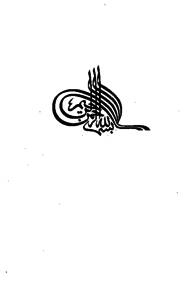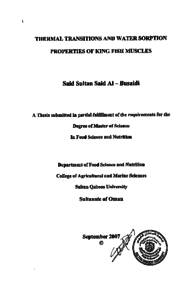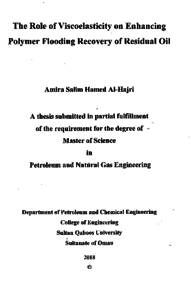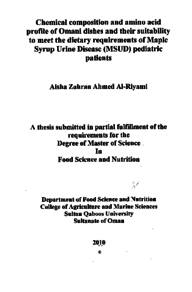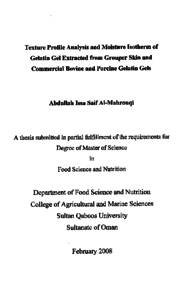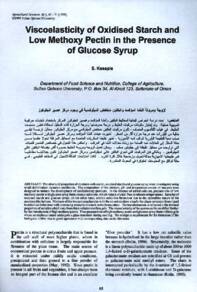Document
Viscoelasticity, crystallinity and phase behavior of high sugar/polysaccharide systems relevant to the food industry
Publisher
Sultan Qaboos University
Gregorian
2001
Language
English
Subject
English abstract
In processed foodstuffs, biopolymers are widely used to create a structured body. In the case of high solid products, such as in confectioneries, they are used to maintain the rubbery (jelly babies, gummy bears, etc.) or glassy (boiled down sweets) texture required by the consumer. The objective of this thesis is to build a knowledge base and associated understanding of the viscoelastic and textural properties in terms of the glass transition and glassy state of model systems containing high levels of sugar in combination with low levels of polysaccharide. In addition, the aim is also to show that sugars can cause massive changes in the nature of the polysaccharide structures, which can then be employed by the confectionery industry. The following biopolymers, type-A gelatin, K-carrageenan, locust bean gum, and guar gum were used in this investigation. Rheology in the form of small deformation oscillation testing, using the controlled-strain ARES (Advanced Rheometric Expansion System) was employed to characterize the formation of structure with different viscoelastic properties in high solid systems, thus following vitrification or crystallization of the samples occurring with decreasing temperature. Samples were cooled and heated at 2°C/min between 90°C and -55°C; taking frequency sweeps at
constant temperature intervals through the rubber to glass transition. Rheologically, the glass transition temperature (Tg) determines the distinction between a soft rubbery product and that of a brittle glassy type. At the glass transition region, the free volume approach is applicable, where molecules still bear free volume whereas when molecules no longer have free volume they are said to be in the glassy state due to dense and compact packing. It is known that the gelatin network binds the water molecules, but at subzero temperatures their inherent mobility leads to ice formation because solute molecules DUSE can move out of the way, thus allowing water to freeze and ice crystal to grow. In our study, we have shown that the addition of high levels of co-solute (and molecular weight), prevented ice formation as a result of the interaction of sugar and water
molecules creating a viscous medium with reduced relaxation time and diffusion mobility. But when the total amount of solids (sugar) was reduced, molecular mobility increased allowing water to freeze and thus leading to small molecule crystallinity at sub-zero temperatures. On the other hand, when the concentration of the polymer was increased, the system with a high gelatin content formed a structure at a relatively higher temperature than the system with a lower gelatin content. An investigation by Vasiliki Evageliou et al., 1998, 'has showed that addition of high levels of co-solute to 0.5% K-carrageenan in the presence of 10 mM KCl induces a transformation from an enthalpic aggregated structure to a partially crossed linked structure of more flexible chains. Hence, when we doubled the amount of K carageenan and added salt, the network of K-carrageenan showed extensive aggregation, which was capable of preventing the formation of a true glass. In terms of the glass transition temperature (Tg), the Tg shifts to higher temperature as we increase the concentration or molecular weight of the system. Therefore, the plasticising effect of 0.5% guar gum in a high solid environment compared to 1% guar gum resulted in a lower Tg than 1% guar. To verify the truth of the preceding statement, 1% K-carrageenan with 5mM of KCl was employed to induce limited intermolecular association and has proven to vitrify at much higher temperatures than 1% guar gum.
Description
Thesis
Member of
Resource URL
Arabic abstract
تستخدم البوليمرات الحيوية على نطاق واسع في المواد الغذائية المصنعة لخلق بنية مركبة. في المنتجات عالية الصلابة مثل الحلويات ، تستخدم البوليمرات المحافظة على بنية المواد المطاطية (مثل الهلام المصنع للاطفال والمواد الصمغية ...الخ) أو المواد الزجاجية (مثل الحلويات المنخفضة بالغليان المطلوبة من قبل المستهلك. إن الغرض من هذه الأطروحة هو معرفة وفهم خواص اللزوجة والقوام من حيث التحول الزجاجي والوضع الزجاجي للأنظمة النموذجية التي تحتوي على مستويات عالية من السكر تترافق مع مستويات منخفضة من المركبات السكرية المتعددة. وتهدف أيضا إلى توضيح امكانية قيام السكريات بإحداث تغيرات كبيرة في طبيعة تركيب المركبات السكرية المتعددة والتي يمكن بعد ذلك تطبيقها على صناعة الحلويات. تم في هذا البحث استخدام بوليمرات متعددة وهي جيلاتين نوع أ، والكراجين ك، وصمغ حبوب شجرة الخرنوب، وصمغ الغوار. تم استخدام بحث الإنسياب في شكل اختبار صغير التشوه التذبذبي باستعمال الجهد الموجه (Advanced Rheometric ) ( ARES Expanstion) وذلك لتمييز تكوين البنية بخواص اللزوجة المختلفة في System أنظمة عالية الصلابة، وبالتالي متابعة تزجج أو تبلور العينات والذي يحدث مع درجات الحرارة المتناقصة. تم تبريد وتسخين العينات عند ۲ درجة مئوية دقيقة ما بين 90 و55 درجة مئوية، آخذة مدى التردد على فواصل زمنية عند درجة حرارة ثابتة من خلال التحول من المطاطية إلى التزجج. انسيابية، نجد أن درجة حرارة التحول (Tg)" إلى التزجج تحدد التمييز بين منتج مطاطي طري وبين النوع الزجاجي سهل الإنكسار. ويجب تطبيق "طريقة الحجم الحر" في منطقة التحول الزجاجي عندما تكون الجزيئات ذات حجم حر. وعندما لا يكون للجزئيات حجم حر توصف عندئذ بأنها في حالة زجاجية وذلك نتيجة للتعبئة الكشفية والمحكمة. من المعروف إن شبكة الجيلاتين تربط جزئيات الماء، ولكن عند درجات الحرارة ما دون الصفر تؤدي الحركة الملازمة إلى تجمد الماء وتكون بلورات الثلج (تكون الثلج)، نظرا لأن الجزئيات المذابة يمكن أن تتحرك بعيدة. لقد أوضحنا في دراستنا أن إضافة مادة مذابة متحدة ووزن جزيئي) حال من تكون الثلج بسبب تفاعل جزئيات السكر والماء الذي أحدث وسطا الزجا مع تراضي. وتحركيه انتشار مخفضة. ولكن بتخفيض إجمالي كمية المواد الصلبة (السكر)، زادت تحركية الانتشار وسمحت بتجمد الماء ومن ثم يتبلور الجزيئات عند درجات الحرارة ما دون الصفر. من ناحية أخرى، عند زيادة نسبة التركيز البوليمر، يشكل النظام ذو نسبة عالية من الجيلاتين تركيبة في وجود حرارة مرتفعة نسبيا مقارنة مع النظام ذو نسبة أقل من الجيلاتين. وقد أوضحت دراسة أجراها 1998 ,.Vasiliki Evageliou et al، إن إضافة مستويات عالية من مادة مذابة متحدة إلى %5. كراجين لك في وجود KCl ۱۰mM يحدث تحولا من بنية ذات وحدة حرارية كلية إلى بنية متزاوجة الوصل ذات سلاسل أكثر مرونة. لذلك، عندما ضوعفت كمية الكراجين ك وأضيف الملح، أظهرت شبكة الكراجين ك تجمعا مكثفا استطاع منع تكون زجاج حقيقي. من حيث درجة الحرارة التحول الزجاجي (Tg)" ، فإنها تنتقل إلى درجة حرارة أعلى بينما يزيد تركيز النظام أو وزنه الجزيئيء. لذلك فانه عند مقارنة التأثير اللدائني بين %۰,. ضمغ غوار و %۱ صمغ غوار في بيئة عالية الصلابة، وجد أن %5. صمغ غوار أدى إلى انخفاض درجة حرارة التحول مقارنة مع % اصمغ غوار. للتحقق من صحة هذا ، أستخدم %1 كراجين لك معKCl emM لإحداث ترابط جزيئي داخلي محدود حيث ثبت أنها تزجج عند درجات حرارة أعلى من %۱ صمغ غوار.
Category
Theses and Dissertations

